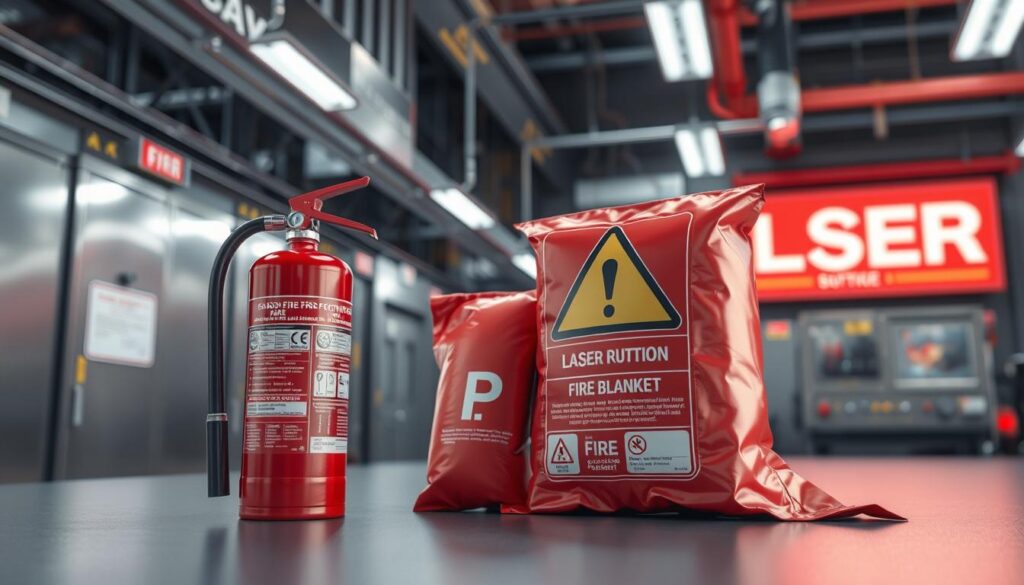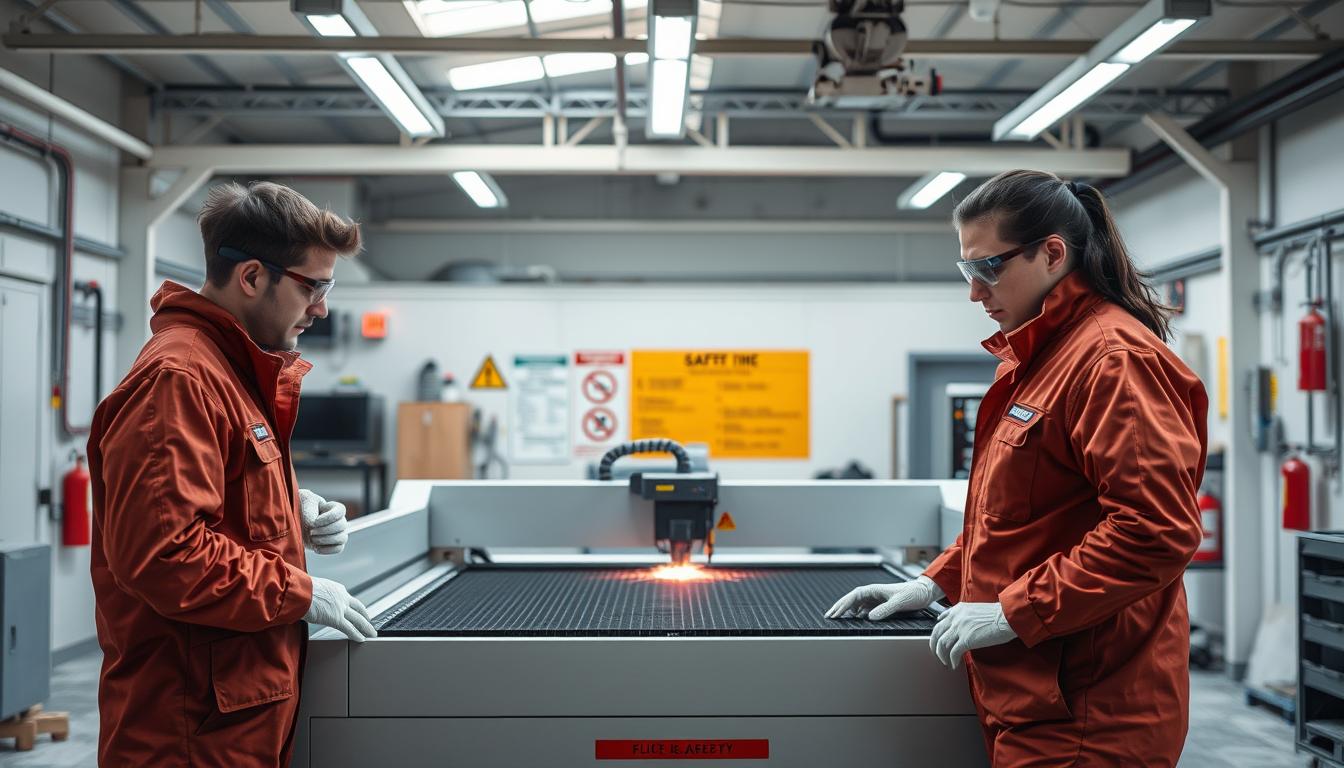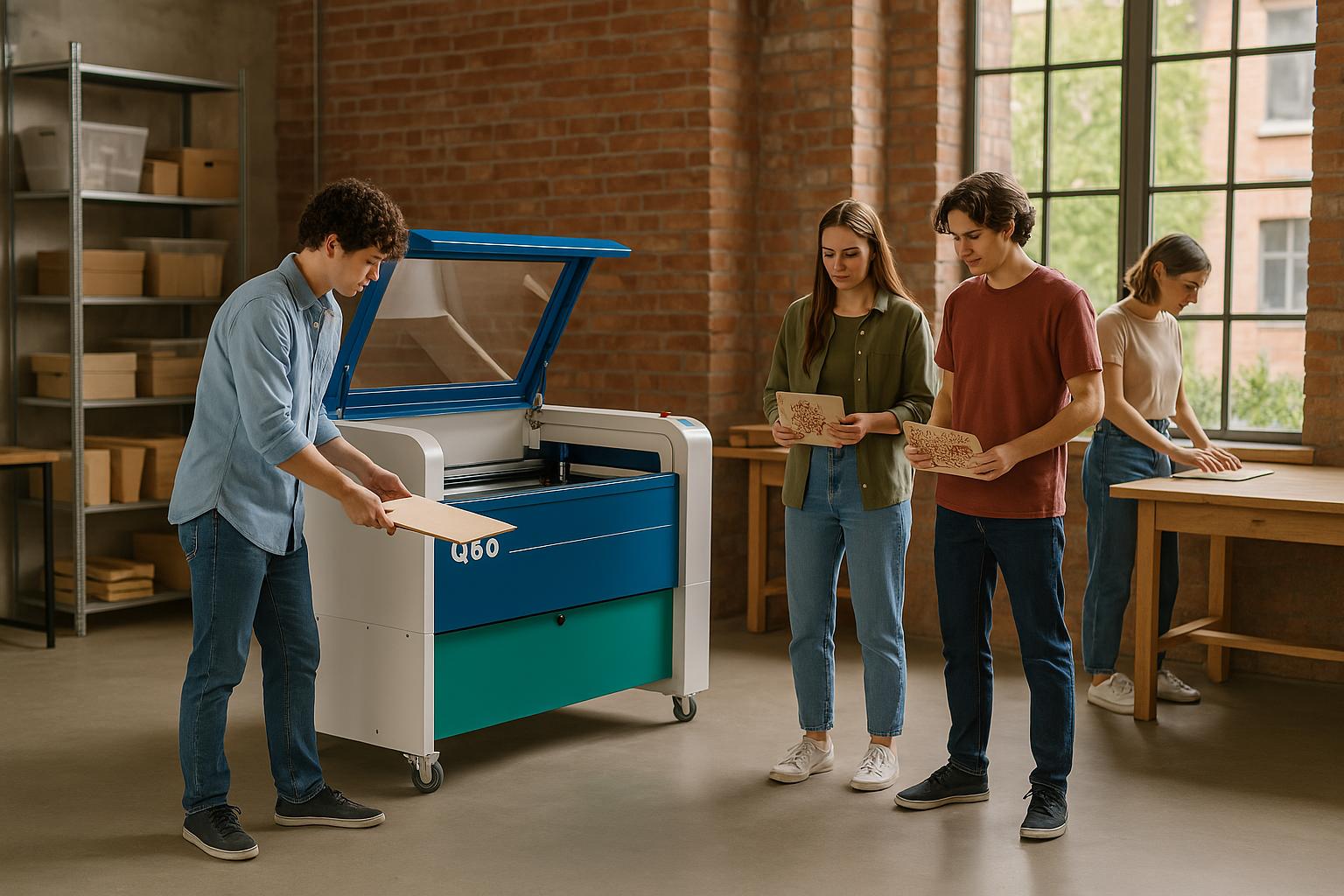Laser cutting machines are precise and efficient. But, knowing about laser cutting safety is key. These machines can emit intense light and heat, posing risks. This guide will help you operate lasers safely, reducing risks.
This guide covers everything from handling materials to emergency plans. By focusing on safety, users can work efficiently without risking their health.
Understanding Laser Cutting Technology and Its Risks
Laser cutters are powerful and precise, but it’s important to know how they work to stay safe. These machines use light beams to cut materials. Qlaser and SLC lasers are the most common types. The laser beam dangers come from the intense heat and light, which can burn skin or damage eyes if not handled carefully.
Risk Assessment Before Operation
Do a laser cutting risk assessment before starting to spot potential dangers. Look for:
| Step | Action | Purpose |
|---|---|---|
| 1 | Inspect beam alignment and safety interlocks | Prevent accidental exposure to the beam |
| 2 | Test exhaust systems | Reduce fume inhalation risks |
Doing a thorough laser cutting risk assessment helps avoid problems like electrical issues or using the wrong materials.
Essential Personal Protective Equipment for Laser Operations
Protecting yourself starts with the right laser safety glasses and other PPE for laser cutting. These items are the first defense against intense light, debris, and harmful fumes. It’s crucial to have laser cutting eye protection that matches the laser’s wavelength and power to avoid eye damage. Look for certifications like ANSI Z136.1 to ensure it works well.
- Laser safety glasses: Choose models rated for your machine’s output wavelength. Amber or mirrored lenses block dangerous light without blocking your view.
- Protective clothing: Wear flame-resistant, non-reflective clothes to avoid accidental reflections or ignition from stray beams.
- Respiratory masks: Use particulate respirators when cutting materials that release toxic fumes, like certain plastics or coated metals.
Proper laser protective equipment also includes durable gloves for handling hot materials and shields to guard against flying debris. Always check laser safety gear before use. Scratched glasses or frayed gloves reduce protection. Replace items promptly when damaged or after recommended use periods.
When selecting gear, match the equipment’s optical density (OD) rating to your laser’s power class. For example, Class 4 lasers require higher OD-rated laser cutting eye protection than lower classes. Training is key—operators must understand how each piece of PPE for laser cutting works in their specific setup.
Setting Up a Safe Laser Cutting Environment
Creating a safe laser workshop starts with careful planning. It’s important to protect both the equipment and people. Follow these steps to reduce risks and meet safety standards.
Proper Workspace Layout
Make your laser cutting area safe by planning it well. Keep at least 3 feet of space around machines for quick access in emergencies. Use flooring that doesn’t reflect light to avoid beam scatter. Store materials in specific areas, away from laser paths. Cluttered spaces can cause tripping and block emergency exits.
Ventilation Requirements
A good laser cutting ventilation system removes harmful fumes. Install exhaust systems with HEPA filters for cutting metal or plastic. Keep airflow at 6-8 air changes per hour and clean filters every month. Regular upkeep stops combustible dust from building up.
Electrical Safety Considerations
- Ground all equipment to prevent static buildup
- Use surge protectors rated for high-power devices
- Install emergency kill switches within arm’s reach
Signage and Access Control
Put up laser safety signage at entry points, showing laser classification levels. Use laser access control with keycards or biometric locks. Only let trained people in and post warning labels near emergency shutoffs.
Material Safety Guidelines for Laser Cutting
Choosing the right materials is key to avoiding laser cutting fumes and material hazards. Always pick safe materials for laser cutting like acrylic, wood, or metals like stainless steel. These materials produce little harmful emissions.
Stay away from toxic materials laser cutting can create. Prohibited laser materials include PVC, which releases harmful chlorine gas when burned. Also, avoid materials with heavy metals like lead-based paints. Never cut unknown substances without first testing for hazards.
- Prohibited Materials: PVC, polycarbonate, rubber, and any treated wood with chemical preservatives.
- Safe Alternatives: Opt for acrylic (polymethyl methacrylate), glass, or aluminum for reduced fume risk.
- Always Check: Material Safety Data Sheets (MSDS) to confirm combustion byproducts before cutting.
Make sure materials are securely placed to prevent shifting during cutting. Store prohibited laser materials separately and label them clearly. If unsure, consult a professional to identify unknown materials and assess potential risks. Prioritizing material safety ensures both operator health and machine longevity.
Safety Tips for Working with Laser Cutting Machines: Pre-Operation Checklist
Before starting any job, a reliable laser cutting checklist ensures every safety protocol is addressed. Follow these steps to prevent hazards and maintain equipment longevity.
Machine Inspection Protocol
Start with a laser machine inspection to check for loose parts, damaged lenses, or blocked cooling systems. Make sure safety interlocks and emergency stops work right. Clean the work area to avoid fires or malfunctions. This machine safety protocol is key for every job.
Software Safety Settings
Check laser software safety settings before each use. Adjust power levels, focus distance, and cutting speeds for the material. Disable unsafe overrides and ensure job files match material thickness. Wrong settings can cause burns or damage the lens.
Material Verification Steps
Make sure materials follow manufacturer guidelines with a laser cutter pre-operation checks list. Check thickness, flammability, and compatibility with the laser type. Secure materials firmly to prevent shifting during cutting.
By following these steps, you reduce risks and improve precision. Download a free laser cutting checklist template from industry safety guides to make your workflow smoother.
Operating Procedures to Prevent Accidents
Learning laser cutting procedures means following strict safety steps. Operators must stick to a clear process to lower risks while cutting.
- Always start with a first-cut test on scrap material to confirm settings align with job requirements.
- Never leave the machine unattended during operation; constant laser machine monitoring prevents overheating or misfires.
- Position yourself to the side of the laser beam path, maintaining a safe distance from the work area.
| Step | Action | Purpose |
|---|---|---|
| 1 | Run startup diagnostics | Verify system readiness |
| 2 | Test cut on scrap | Ensure accuracy before production |
| 3 | Monitor for fumes/smoke | Support laser accident prevention |
| 4 | Follow shutdown protocol | End sessions with safe laser practices |
Quick responses to irregular noises or odors are critical. Use emergency stop buttons only in crises and log all incidents. Always prioritize laser cutting safe operation by avoiding multitasking near the machine. These safe laser practices build a routine that minimizes risks at every phase of operation.
Maintenance Practices for Safe Equipment Performance
Keeping laser systems in top shape with preventative maintenance ensures they work safely and well. Neglecting maintenance can lead to accidents. Regular laser cutter maintenance stops failures and makes tools last longer.
Regular Cleaning Guidelines
Here’s how to keep your machine in great shape:
- Wipe surfaces daily to remove dust and debris.
- Clean laser optics with approved solvents to avoid damage.
- Use the right techniques to avoid scratching delicate parts.
Component Inspection Schedule
Regular laser machine inspection finds problems early. Follow this schedule:
| Component | Frequency | Notes |
|---|---|---|
| Laser optics | Monthly | Check alignment and cleanliness. |
| Cooling systems | Quarterly | Inspect for leaks and blockages. |
| Mechanical parts | Bi-weekly | Look for wear on moving components. |
Lens and Mirror Maintenance
Clean laser optics with care. Use lint-free cloths and approved cleaners. Replace broken lenses right away. Check for scratches weekly to avoid bad cuts.
Documentation and Logging
Keep a laser cutting maintenance log for all work. Record each inspection and repair. Include:
- Date and time of each check.
- Parts cleaned or replaced.
- Notes on issues found.
Fire Safety and Emergency Response
Fire hazards in laser cutting need strict laser fire prevention steps. Sparks, flammable stuff, and electrical issues can start fires fast. Having the right laser emergency equipment and knowing laser cutting emergency procedures is key to keep people and gear safe.

Every work area must have laser emergency equipment like Class BC fire extinguishers and fire blankets. Put extinguishers near exits and laser units, with clear signs. Check them monthly to make sure they’re ready and easy to find.
Laser accident response training covers first aid for burns and eye injuries. Keep first-aid kits close. After incidents, write down what happened and check the equipment before starting work again. Regular drills help everyone know their part in emergencies.
Training Requirements and Certification
Safe laser cutting starts with proper education and credentials. Employers must prioritize laser cutting training programs. These should cover all operational and safety protocols. Basic skills include equipment handling, emergency response, and hazard identification. Let’s explore the steps needed to build a skilled, certified team.
Basic Training Elements
Foundational programs focus on:
| Element | Key Topics |
|---|---|
| Machine Controls | Learning panel interfaces and safety interlocks during laser cutting education. |
| Risk Management | Identifying fire hazards, fumes, and beam exposure risks. |
| Emergency Drills | Practicing emergency stops and fire extinguisher use. |
Advanced Safety Certification
For specialized roles, formal credentials like laser safety certification are required. These include:
- ANSI Z136 compliance courses for industrial settings.
- Laser operator qualification programs for medical or aerospace applications.
- Online and in-person laser safety courses from accredited providers.
Refresher Course Recommendations
Staying updated is critical as tech evolves. Consider:
- Retraining every 24 months to refresh skills.
- Modules on new equipment models or software updates.
- Annual quizzes to test knowledge retention.
Certification isn’t a one-time task—it’s a continuous journey. It protects workers and meets legal standards.
Conclusion: Creating a Culture of Safety in Your Laser Cutting Workshop
A laser safety culture makes safety a shared goal, not just a rule. When teams follow safety rules like wearing PPE and doing risk assessments, they build sustainable laser safety. This approach keeps operations safe, boosts efficiency, and builds trust.
Good laser workshop management needs clear rules and open talks. Regular checks and training keep laser safety implementation strong. This keeps everything up to OSHA standards. Asking for feedback helps everyone stay responsible.
Long-term laser safety needs constant work. Focusing on safety now means fewer accidents and better following of rules. When every step is done safely, workshops can operate safely for many years.
FAQ
What is laser cutting technology and how does it work?
Laser cutting uses a focused light beam to cut or engrave materials. The light beam comes from excited atoms in gas or solid materials. It’s directed by mirrors and focused through a lens onto the material for precise cuts.
What personal protective equipment (PPE) is necessary for laser cutting?
You need laser safety goggles, gloves, and protective clothing for laser cutting. Respiratory masks are also important for handling fumes. Choose PPE based on the laser type and materials used.
How can I ensure a safe laser cutting environment?
Keep your workspace clear and well-ventilated. Follow electrical safety standards and use signs to limit access. These steps help prevent accidents.
What steps should I take for a pre-operation checklist before using a laser cutter?
Check the laser machine for damage and verify software settings. Make sure materials are compatible. Regular checks help spot hazards early.
How do I respond if there’s a fire or emergency during laser operations?
Follow emergency procedures by shutting down the machine and using the right fire extinguisher. Evacuate if needed. Make sure everyone knows the emergency exit routes and procedures.
What training is required to operate a laser cutter safely?
You need basic training on the equipment and emergency procedures. Also, get advanced safety certification. Regular refresher courses keep you up-to-date with safety protocols.



